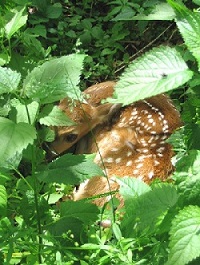
Deer drop fawns in our front yard labyrinth.
Few gardening experiences are as frustrating as discovering a patch of almost ready-to-bloom tulips or ready-to-pick green beans devoured by deer.
Over the past couple of decades deer populations have skyrocketed across North America, making gardening challenging. We have plenty of deer at Winding Pathways and have tried or researched many ways to either eliminate or greatly reduce damage. Here they are:
PLANT CROPS, FLOWERS AND SHRUBS DEER DON’T LIKE: This only sort of works. There are a few plants deer don’t like to eat. Books, blogs, and magazine articles contain lists of plants deer don’t like, but beware. As deer herds increase they get every hungrier, eliminate their favorite foods, and then chow down on plants they don’t particularly like. Also, deer seem to have regional preferences. Connecticut deer may avoid a certain plant that Iowa counterparts love. Winding Pathways Advice: Assume that sooner or later deer will eat just about any plant with only a few exceptions.
KENNEL A BIG DOG IN THE GARDEN: We haven’t tried this one but we’re guessing that the deer will soon figure out that the dog is tied or fenced in and they’ll eat plants just out of Fido’s reach. Winding Pathways Advice: Fido might help but don’t count on him.
SPRAY DEER REPELLENTS ON DESIRABLE PLANTS: It works much of the time. Many commercial repellents are on the market. We’ve made ours from egg yolks blended in water, strained through a nylon stocking to remove most of the thicker egg material and sprayed on plants. At best it is a temporary solution. Really hungry deer will eat the plants anyway, and rain washes most repellents off. Read labels. Some commercial repellents may not be safe on vegetables. Winding Pathways Advice: Repellents help but need to be reapplied after each rain and the deer will find the one plant you overlooked!
BUILD A FENCE: Tall mesh fences work. Electric fences work. Electrified mesh fences work the best. If you want a surefire way to keep deer out build a sturdy fence all the way around the garden. Unfortunately, there are some disadvantages of fencing as follows:
- Electric and tall nonelectric fences are often prohibited by town ordinances
- Fences are expensive but last a long time.
- Fences can be unsightly
- Fences are barriers to both deer and people. Building a fence means passing through a gate every garden visit.
Fences work. If nonelectrified they should be at least seven feet tall. Eight is better. Electric fences don’t need to be as tall and can be several strands of wire or (better) an electrified mesh.
Winding Pathways Advice: This is the one surefire way of keeping deer away from valuable plants. Just remember to close the gate!
WHAT WE’VE DONE AT WINDING PATHWAYS
We take a comprehensive approach to reducing deer damage to our labyrinth, vegetable garden and favorite landscape plants. Here is what we have done and are contemplating.
- Built a 7-foot tall nonelectric fence around our smallish vegetable garden.
- Built sturdy nonelectric fences around young trees.
- Use repellents frequently on special non edible plants.
- Buy a deer tag and harvest one deer per year. It’s legal where we live and we enjoy this
“local free ranging, organic” meat.
We’re considering buying and setting up an electric mesh fence around our labyrinth.
Farm and garden stores sell a wide diversity of nonelectric fencing. Our favorite resource for fences is Premier1. Their FENCES THAT WORK catalog is an outstanding resource. Check out Premier1 in Washington, IA.

